Radionuclide sorption dynamics in the Rhone River: Experimental and modelling approach
Résumé
The transfer of radionuclides discharged into rivers by nuclear facilities are conditioned by their solid/liquid fractionation, commonly represented by an equilibrium approach using the distribution coefficient K_d. This coefficient, largely used in modeling, assumes an instantaneous and completely reversible reaction. However, such assumptions are rarely verified. Compared to instantaneous adsorption of radionuclides onto particles, slower reactions may lead to an underestimation of the dissolved fraction, and modifications of environmental conditions (e.g. at confluences, dams…) may induce a change in solid/liquid partition. Considering this background, this study aims to assess whether models incorporating one or more kinetics to describe this fractionation allow more accurate estimations than the equilibrium approach. A large dataset has been obtained experimentally to compare and test fractionation models. The exchanges of four radionuclides (137Cs, 60Co, 54Mn, and 110mAg) between solution and riverine suspended particulate matter (from the Rhone River, France) were followed in laboratory. Adsorption kinetics were monitored starting from 30 minutes up to 2 months. They stabilized only after several days and up to 2 weeks. Dilutions of the contaminated suspension were carried out after 1 hour, 3 days, 10, 21 and 31 days of prior adsorption, to simulate a change in environmental conditions, such as the input of uncontaminated water from a tributary. The dilution induced a quick release from solid to liquid at first, followed by a non-expected re-adsorption for all four radionuclides. 31-days sorption data were used to fit the parameters of a Kd model and derived models involving one (EK) or two fractionation kinetics (KK). Predictions were then carried out to evaluate the model capacities to react to a dilution of the contamination. Unlike the Kd model, which is a constant, the kinetic models predicted a variation in the solid/liquid activity ratio over time and when environmental conditions changed. However, models developed on one-step sorption showed limitations to reproduce the adsorption kinetics observed after a dilution, especially when a previous steady-state was reached




